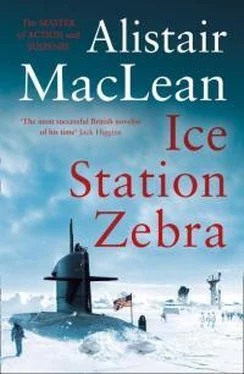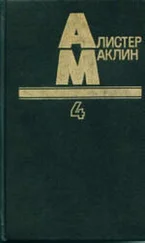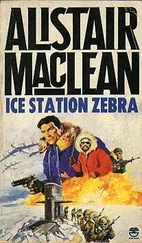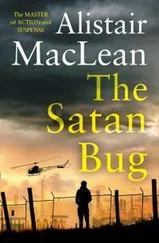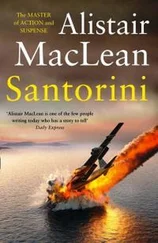‘What do you have in mind?’
‘You know damn’ well what I have in mind,’ I said impatiently. ‘Drill a hole in the door of the after collision bulkhead, screw in a high-pressure hose, open the door, shove someone in the narrow space between the two collision bulkheads and turn up the hose until the pressure between the collision bulkheads equals that in the torpedo room. You have the clips eased off the for’ard collision door. When the pressures are equalised it opens at a touch, you walk inside, close number four rear door and walk away again. That’s what you had in mind wasn’t it?’
‘More or less,’ he admitted. ‘Except that you are no part of it. Every man on this ship has made simulated escapes. They all know the effects of pressure. And most of them are a great deal younger than you.’
‘Suit yourself,’ I said. ‘But age has little to do with the ability to stand stresses. You didn’t pick a teen-ager as the first American to orbit the earth, did you? As for simulated escapes, making a free ascent up a hundred-foot tank is a different matter altogether from going inside an iron box, waiting for the slow build-up of pressure, working under that pressure, then waiting for the slow process of decompression. I’ve seen young men, big, tough, very, very fit young men break up completely under those circumstances and almost go crazy trying to get out. The combination of physiological and psychological factors involved is pretty fierce.’
‘I think,’ Swanson said slowly, ‘that I’d sooner have you – what do the English say, batting on a sticky wicket – than almost any man I know. But there’s a point you’ve overlooked. What would the Admiral Commanding Atlantic Submarines say to me if he knew I’d let a civilian go instead of one of my own men?’
‘If you don’t let me go, I know what he’ll say. He’ll say: “We must reduce Commander Swanson to lieutenant, j-g., because he had on board the Dolphin an acknowledged expert in this speciality and refused, out of stiff-necked pride, to use him, thereby endangering the lives of his crew and the safety of his ship.” ’
Swanson smiled a pretty bleak smile, but with the desperately narrow escape we had just had, the predicament we were still in and the fact that his torpedo officer was lying dead not so many feet away, I hardly expected him to break into gales of laughter. He looked at Hansen: ‘What do you say, John?’
‘I’ve seen more incompetent characters than Dr Carpenter,’ Hansen said. ‘Also, he gets about as nervous and panic-stricken as a bag of Portland cement.’
‘He has qualifications you do not look to find in the average medical man,’ Swanson agreed. ‘I shall be glad to accept your offer. One of my men will go with you. That way the dictates of common sense and honour are both satisfied.’
It wasn’t all that pleasant, not by quite a way, but it wasn’t all that terribly bad either. It went off exactly as it could have been predicted it would go off. Swanson cautiously eased the Dolphin up until her stern was just a few feet beneath the ice: this reduced the pressure in the torpedo room to a minimum, but even at that the bows were still about a hundred feet down.
A hole was drilled in the after collision bulkhead door and an armoured high-pressure hose screwed into position. Dressed in porous rubber suits and equipped with an aqualung apiece, a young torpedoman by the name of Murphy and I went inside and stood in the gap between the two collision bulkheads. High-powered air hissed into the confined space. Slowly the pressure rose: twenty, thirty, forty, fifty pounds to the square inch. I could feel the pressure on lungs and ears, the pain behind the eyes, the slight wooziness that comes from the poisonous effect of breathing pure oxygen under such pressure. But I was used to it, I knew it wasn’t going to kill me: I wondered if young Murphy knew that. This was the stage where the combined physical and mental effects became too much for most people, but if Murphy was scared or panicky or suffering from bodily distress he hid it well. Swanson would have picked his best man and to be the best man in a company like that Murphy had to be something very special.
We eased off the clips on the for’ard bulkhead door, knocked them off cautiously as the pressures equalised. The water in the torpedo room was about two feet above the level of the sill and as the door came ajar the water boiled whitely through into the collision space while compressed air hissed out from behind us to equalise the lowering pressure of the air in the torpedo room. For about ten seconds we had to hang on grimly to hold the door and maintain our balance while water and air fought and jostled in a seething maelstrom to find their own natural levels. The door opened wide. The water level now extended from about thirty inches up on the collision bulkhead to the for’ard deckhead of the torpedo room. We crossed the sill, switched on our waterproof torches and ducked under.
The temperature of that water was about 28° F. – four below freezing. Those porous rubber suits were specially designed to cope with icy waters but even so I gasped with the shock of it – as well as one can gasp when breathing pure oxygen under heavy pressure. But we didn’t linger, for the longer we remained there the longer we would have to spend decompressing afterwards. We half-walked, half-swam towards the fore end of the compartment, located the rear door on number 4 tube and closed it, but not before I had a quick look at the inside of the pressure cock. The door itself seemed undamaged: the body of the unfortunate Lieutenant Mills had absorbed its swinging impact and prevented it from being wrenched off its hinges. It didn’t seem distorted in any way, and fitted snugly into place. We forced its retaining lever back into place and left.
Back in the collision compartment we gave the prearranged taps on the door. Almost at once we heard the subdued hum of a motor as the high-speed extraction pumps in the torpedo room got to work, forcing the water out through the hull. Slowly the water level dropped and as it dropped the air pressure as slowly decreased. Degree by degree the Dolphin began to come back on even keel. When the water was finally below the level of the for’ard sill we gave another signal and the remaining over-pressure air was slowly bled out through the hose.
A few minutes later, as I was stripping off the rubber suit, Swanson asked: ‘Any trouble?’
‘None. You picked a good man in Murphy.’
‘The best. Many thanks, Doctor.’ He lowered his voice. ‘You wouldn’t by any chance–’
‘You know damned well I would,’ I said. ‘I did. Not sealing-wax, not chewing-gum, not paint. Glue, Commander Swanson. That’s how they blocked the test-cock inlet. The old-fashioned animal hide stuff that comes out of a tube. Ideal for the job.’
‘I see,’ he said, and walked away.
The Dolphin shuddered along its entire length as the torpedo hissed out of its tube – number 3 tube, the only one in the submarine Swanson could safely rely upon.
‘Count it down,’ Swanson said to Hansen. ‘Tell me when we should hit, tell me when we should hear it hit.’
Hansen looked at the stop-watch in his bandaged hand and nodded. The seconds passed slowly. I could see Hansen’s lips move silently. Then he said: ‘We should be hitting – now,’ and two or three seconds later: ‘We should be hearing – now.’
Whoever had been responsible for the settings and time calculations on that torpedo had known what he was about. Just on Hansen’s second ‘now’ we felt as much as heard the clanging vibration along the Dolphin’s hull as the shock-waves from the exploding war-head reached us. The deck shook briefly beneath our feet but the impact was nowhere nearly as powerful as I had expected. I was relieved. I didn’t have to be a clairvoyant to know that everyone was relieved. No submarine had ever before been in the vicinity of a torpedo detonating under the ice-pack: no one had known to what extent the tamping effect of overhead ice might have increased the pressure and destructive effect of the lateral shock-waves.
Читать дальше
Конец ознакомительного отрывка
Купить книгу
